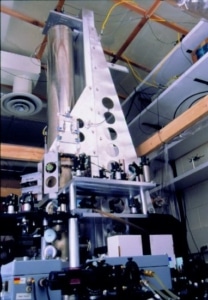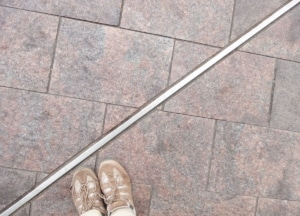DCPA NEWS CENTER
Enjoy the best stories and perspectives from the theatre world today.
Enjoy the best stories and perspectives from the theatre world today.
One of the key plot twists in Back to the Future involves the Hill Valley Court House clock tower. In the year 1955, time would have been measured in this clock tower by Earth’s position in relation to the sun, moon and the heavens. The time on every clock in the world was based on the movement of stars in the sky.
But that’s no longer true. Since 1967, time is now measured on a more reliable hyperfine energy transition in the isotope of cesium known as cesium-133. Don’t try to understand that but hold on to your hats – all time in the United States is based on one atomic clock. And that clock is located, of all places, in Boulder, Colorado!

NIST-F1, the first atomic clock in Boulder. Photo by National Institute of Standards and Technology – Physics Laboratory: Time and Frequency Division
It was a profound (if unrecognized) moment in history when time ceased to be based on the stars in the heavens, but instead on atoms on Earth. How this happened is a 5,000-year story. And it’s not over by a long shot.
The current atomic clock in Boulder, NIST-F2, will lose or gain one second every 300 million years. But a new clock, JILA, has been created in Boulder that will not lose or gain one second accuracy for 30 billion years. Why is that important? Because accurate time measurement is crucial to applications including GPS navigation, telecommunications networks, financial markets, scientific research and space exploration. The more accurate the clock, the better your phone is able to tell you the correct time, and also through satellites, let you know exactly where you are on the planet.
But let’s get back to the 1955 clock tower on the Hill Valley Court House. Egyptians were studying time 5,000 years ago and established a system, adopted by the Greeks and Romans, that was used for 2,500 years. It was based on observations of the sun and stars. In 1283, the first weigh-driven time machine that could keep time day and night was invented in Dunstable Priory, England. Since this new device and others like it were primarily used to bring people to church services, they were connected to a bell to alert the villagers of the time. The name for these devices came from a Medieval Latin word for bell — clocca.
Union Station. Photo courtesy Denver Public Library
Jump forward through thousands of inventions in clocks and clock towers around the world and the challenge was not keeping time but communicating it over vast distances. Each town had its own clock, but so did every other town. And they were all different. Noon for these devices could be measured by a reading of the sun, but noon in one town could be a few minutes, an hour, or several hours from a different town to the east or west.
In 1881, Denver opened its grand new Union Station with a 180-foot-tall clock tower for all the world to see. It was the highest building west of the Mississippi. The challenge was, in 1881, there were 144 different time zones in the United States. You could see a time on the clock tower in Union Station, but every train station in America had a clock, and they were all different times! This led to confusion, an impossibility of railroads to meet schedules, and train collisions.
So in 1883, the major railroad companies began to operate on a coordinated system of four time zones. Denver’s original Union Station iconic clock tower burned down in 1894, but the new tower adopted to the four time zone idea and the clock was set to times sent by telegraph from Harvard University.

The 105th meridian line outside Union Station
At the 1884 International Meridian Conference in Washington, D.C., the globe was divided into 24 time zones with the Royal Observatory in Greenwich, England, chosen as the prime meridian (zero degrees longitude, the line from which all other longitudes are measured).
By an incredible coincidence and without any intention, the 105th meridian (which is halfway through the middle of the Mountain time zone, two hours behind New York, and one hour before Los Angeles) not only goes through Denver, but cuts right through Union Station! There is a steel bar embedded in the paving of Wynkoop Plaza in front of the station showing the line of the 105th meridian as it enters the station. A display panel inside the west doors of Union Station provides a history of meridian lines and shows how they work in setting time zones around the world.
There are other clock towers in Denver – the famous D&F Tower on the 16th Street Mall and the clock tower in the City & County Building on Civic Center Park. But if you are sitting in a theatre and want to really know when the show will start, consult your phone. It’s receiving links from the atomic clock in Boulder, as are all the other 300 million people in America. Just remember, while you’re looking at the time in the theatre, don’t forget to turn off your phone.
